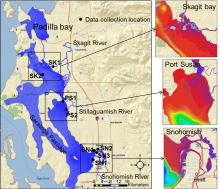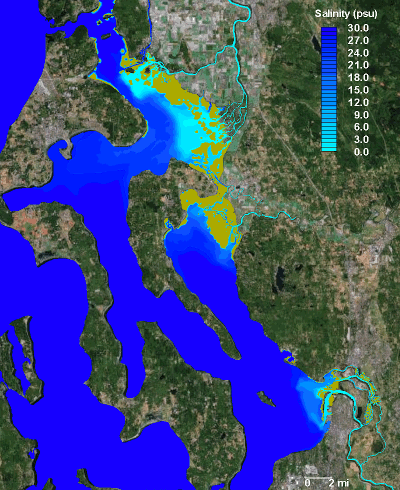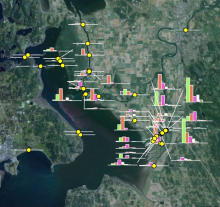Multi-Estuary
Cumulative Effects of Nearshore Restoration on Habitat and Fish Migration in Northern Puget Sound, Washington

The loss of habitat is regarded as one of the major causes for declining fish stocks. It is caused by thousands of kilometers of estuarine shorelines being modified for flood protection and agriculture through the construction of dikes and other artificial structures. In the Pacific Northwest, especially in the Columbia River and Puget Sound estuaries, a number of local and federally funded projects planned or already under way seek to achieve overall estuarine ecological restoration and fish-stock recovery. This requires planning with respect to competing land-use interests (restoration vs. development) and technical feasibility. In other words, an action ideally suited from the perspective of restoration of ecological functions may result in economic losses because of unexpected outcomes, such as flooding during high flow seasons or land mass loss due to erosion.

Restoration actions planned without the benefit of tools, such as estuarine circulation models and hydraulic and hydrologic analysis packages, run the risk of not achieving the desired outcome because the estuarine response may be different from that envisioned. The objective of this research was to develop a numerical modeling tool and techniques for restoration managers and land-use planners to use when planning and designing restoration actions. We accomplished this goal by refining the methods for incorporating high-resolution light detection and ranging (LiDAR) data into the simulation of estuarine circulation and transport in the intertidal mudflats with wetting and drying marsh features. See animation of freshwater plumes from the Whidbey Basin rivers. The exposed tidal flats are in goldenrod color.
Fish Migration Pathway Tracking Tool

The recovery of fish stock was one of the major goals, so a fish migration pathway tracking model was also developed as part of the overall restoration feasibility assessment tool. The fish migration model is based on the Eulerian-Lagrangian-Agent method; the model uses environmental cues, such as oceanographic properties of water coupled with basic fish behavior rules affecting fish motion. The left-hand panel of the figure below shows migrant population density at fish habitat locations sampled by the Skagit River System Cooperative in year 2002. In right-hand panel below we present simulation of fish migration pathways developed using the fish migration model and fish population data for model calibration.

Summary and Conclusions
The benefits of this effort to use sophisticated three-dimensional models such as the Finite Volume Coastal Ocean Model to simulate estuarine processes in the intertidal zone are best described through examples. The application of this tool on the Skagit River delta has helped demonstrate that proposed solutions for restoring brackish conditions through a few individual or selected freshwater bypass channels as a substitute for a former network of freshwater distributary channels may not be as effective as once believed (Khangaonkar and Yang 2011). Similarly, applying the model on the Snohomish River estuary has provided a strong indication that the effects of restoration actions are not limited to the immediate local environment, but could extend over the entire tidal prism, affecting the hydrodynamic balance of the entire estuary (Yang et al. 2010). The application of the model to generate detailed information about water and particulate motion has alerted planners to the possibility that opening the dikes at localized sites may be ineffective unless fish access and connectivity is restored as well. Recognition of this fact is leading teams to conduct estuary-wide assessments. The methods and techniques developed using Whidbey Basin estuaries as the test domain are fully applicable to other estuaries around the United States, assuming site-specific application to address problems particular to the new location.
Development of the juvenile Fish like Particle Tracking Model (FPTM) using the Eulerian-Lagrangian-Agent Modeling (ELAM) method for the Skagit River delta occurred under this grant. The FPTM reproduced a basic feature of fish population distribution in Skagit Bay. However considerable improvement is needed before the FPTM can be deployed for practical use. Further improvements can be accomplished through tests of diverse combinations of stimuli-response rules, validation of the fish-tracking model using additional field data, and implementation of higher level important rules (death and growth, size and fish property distribution, salinity, etc.). The model may also be improved by more detailed representation of habitat characteristics.
Contacts and Project Team
- PNNL: Tarang Khangaonkar, Zhaoqing Yang, Cheegwan Lee
- Skagit River System Cooperative: Greg Hood, Eric Beamer
- NOAA National Marine Fisheries Service: Correigh Greene, Kurt Fresh
Study Reports and Publications
Lee C, T Khangaonkar, Z Yang, and E Beamer. 2010. Development of a Land Use Planning Tool for Estuarine Habitat Protection, Restoration, and Cumulative Effects Assessment in Northern Puget Sound, Washington. Battelle PNWD-4175, final report submitted to The NOAA/UNH Cooperative Institute for Coastal and Estuarine Environmental Technology (CICEET), by Battelle Pacific Northwest Division, Richland, WA.
Khangaonkar T and Z Yang. 2011. A High Resolution Hydrodynamic Model of Puget Sound to Support Nearshore Restoration Feasibility Analysis and Design. Ecological Restoration, 29(1-2):173-184. doi: 10.3368/er.29.1-2.173.